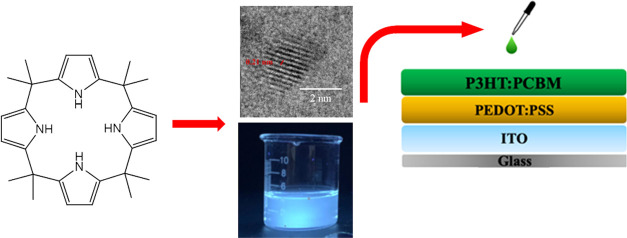- Record: found
- Abstract: found
- Article: found
Development of Highly Luminescent Water-Insoluble Carbon Dots by Using Calix[4]pyrrole as the Carbon Precursor and Their Potential Application in Organic Solar Cells

Read this article at
Abstract

Carbon dots (CDs) are carbon-based fluorescent nanomaterials that are of interest in different research areas due to their low cost production and low toxicity. Considering their unique photophysical properties, hydrophobic/amphiphilic CDs are powerful alternatives to metal-based quantum dots in LED and photovoltaic cell designs. On the other hand, CDs possess a considerably high amount of surface defects that give rise to two significant drawbacks: (1) causing decrease in quantum yield (QY), a crucial drawback that limits their utilization in LEDs, and (2) affecting the efficiency of charge transfer, a significant factor that limits the use of CDs in photovoltaic cells. In this study, we synthesized highly luminescent, water-insoluble, slightly amphiphilic CDs by using a macrocyclic compound, calix[4]pyrrole, for the first time in the literature. Calix[4]pyrrole-derived CDs (CP-DOTs) were highly luminescent with a QY of over 60% and size of around 4–10 nm with graphitic structure. The high quantum yield of CP-DOTs indicated that they had less amount of surface defects. Furthermore, CP-DOTs were used as an additive in the active layer of organic solar cells (OSC). The photovoltaic parameters of OSCs improved upon addition of CDs. Our results indicated that calix[4]pyrrole is an excellent carbon precursor to synthesize highly luminescent and water-insoluble carbon dots, and CDs derived from calix[4]pyrrole are excellent candidates to improve optoelectronic devices.
Related collections
Most cited references65
- Record: found
- Abstract: not found
- Article: not found
Single-Junction Organic Solar Cell with over 15% Efficiency Using Fused-Ring Acceptor with Electron-Deficient Core
- Record: found
- Abstract: found
- Article: not found
WSXM: a software for scanning probe microscopy and a tool for nanotechnology.
- Record: found
- Abstract: not found
- Article: not found